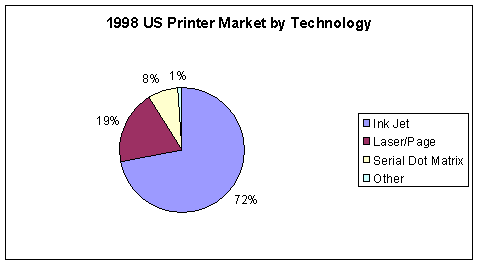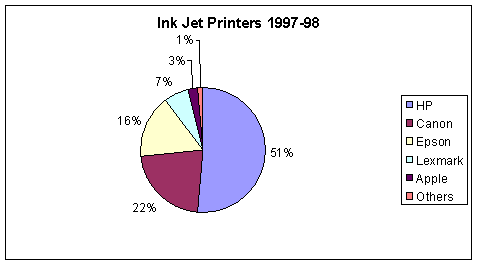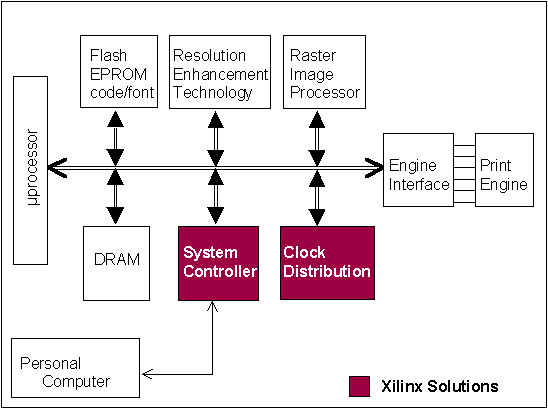Introduction
Printers are everywhere. When you collect cash from an ATM, your receipt
is automatically delivered through a slot from an internal impact printer.
The same happens when you get gas from your local self-serve pump. Dropping
into the local record store, your receipt is impact printed by the cash register
and your concert tickets are imprinted thermally (keep them out of the sun!)
At home, your Ink Jet printer makes Tee-shirt appliqués
and at work, the group laser printer creates your final quarterly
report. We live in a printer world.
This white paper focuses on the market size for the various printer technologies,
both by performance and geographic region. It then discusses the basics of
the technologies, to give a view of their capabilities, limitations and future directions.
A functional block diagram is provided which shows the presence of several important
application specific standard products (ASSP) providers. We'll focus on exactly where
Xilinx XC9500XL CPLDs and Spartan™XL
and Spartan™-II FPGAs play a vital role
in this important market, then take a look into the future direction it is headed
with Internet influence and the new photographic quality printers and MFPs. Finally,
a set of additional resources is provided for further study.
Overview
As suggested in the introduction, printers are everywhere. Their price range
and technologies are all over "the map". We'll focus primarily on
Ink Jet and Laser Printers in this paper, because those are the most likely candidates
for Xilinx programmable solutions. Thermal and impact printers are typically
either on last buy basis or so price sensitive that they cannot support any price
erosion by adding features at no additional cost to the end user. Ink Jet and
Laser printers are another matter. They continue to grow in both features and
geographic markets as prices plummet.
It is interesting to note that critical features are not always obvious in the
printer world, or what was previously acceptable behavior is no longer acceptable.
For instance, the U.S. Department of Energy "Energy
Star" rating is typically an assumed feature in today's printers.
Not so, in the past. We'll see later, that printers do have a substantial power
budget ö due to the nature of the media and process ö that can consume
substantial power (i.e., several watts). Saving power entails turning the controller
on and off. Naturally, there is also a strong trend to reduce "warm-up"
time, which is increased by Energy Star features! Because features tend to
expand over time, programmable logic is a natural technology for printer makers to
embrace.
The next few figures summarize the 1997-1998 market split-outs for printers in
the U.S.

Figure 1 1998 US Printer Market by Technology (Dataquest: 1998)

Figure 2 US Laser/Page Printer Market (Dataquest: 1998)

Figure 3 US Ink Jet Printer Market (Dataquest: 1998)
As noted above, the Ink Jet Market is largest, but with either laser or ink jet
printers, Hewlett-Packard is the largest player. Table 1
below provides some numbers for the appropriate percentages listed above, showing
the magnitude of this huge market.
| Printer Type |
Americas 1997 |
World 1997 |
Americas 1998 |
World 1998 |
| Laser/page |
2,484,000 |
9,509,000 |
2,717,000 |
9,897,000 |
| Ink Jet/serial |
3,357,000 |
40,019,000 |
5,386,000 |
43,498,000 |
Table 1: Annual Units Shipped for 1997 ö 1998
Source: Dataquest 1998
Ink Jet Printers
Ink Jet printers are the largest selling today. They were the first to deliver
full color capability to the average PC owner. The advent of sub $1000 PCs
has driven their price down to where almost anybody can own a sophisticated, fast
printer right on their desktop. For the single user, they are very close to
ideal. Their primary downside is simply operation cost. Ink cartridges
are not cheap. If high quality final copies is important, expensive paper may
also enter the picture. This is the case for PC digital photography, discussed
later. 300 to 600 dots per inch (dpi) are common,
and provide more than acceptable hard copy for today's desktop publishing needs for
day to day report writing and limited publishing.
Typical color Ink Jet printers use two cartridges ö a black one and a color
one. The black one is most economical for text and the color is typically used
for color graphics. Ink technology for both cartridges has evolved substantially
in the last few years. Not only do many printers include automatic "stirring"
functions to keep the ink from plugging, but many include reservoir measuring chips
to let users know how much remaining ink is in the cartridge. Some printers
even use capacity information to determine in advance whether enough ink remains,
to complete a print task prior to beginning it!
The basic mechanism of ink delivery for Ink Jets is heat based. A small
chamber of fluid is heated up and the expanding liquid is "squirted" out
a hole onto the target paper. This is called a nozzle. Canon calls this process
"bubble jet" where others simply call
it "ink jet." There is a new technology using piezo-electric expansion
as a mechanical stimulus for jet delivery. Piezo-electric
jetting avoids thermal issues with ink properties changing as heat is applied.
Piezoelectric market impact is still being determined.
What you see is what you get (WSYWYG) rears its head again with color printing.
When viewing a color monitor screen, the displayed image is constructed from adding
components of red, green and blue (RGB). The
eye is excited by the light sourced from the color monitor. In a similar, but
not identical way, the printed image tracks the screen image by assigning color to
appropriate sites on the white sheet of paper. Sometimes, the screen version
doesn't track the paper version. What you see isn't what you get. Color
applied to a white sheet of paper is not a light source, but rather reflected and
filtered white light. This is a subtle difference, but an important one.
When reflecting light, the Ink Jet ink components are usually Cyan, Magenta, and
Yellow (CMY). These colors subtract with each
other to create the color image, rather than add as RGB do. The process of
reconciling the screen image and the paper image is called "color management."
Most Ink Jets use three colors and black. More expensive units use six or more
colors. Lots of software is employed to assure a consistent image between the
screen and the sheet.
An interesting aside is that black is typically not created well with CMY ö
it usually turns out brown or gray. Hence, the inclusion of a separate black
cartridge for this key color.
The tasks that the printer must perform are complex. The printer must accept
data from the computer, control positioning the print head over the sheet, feed the
sheet (as needed), alter the data appropriately and deliver the ink image to the
sheet. It must subsequently eject the sheet and obtain the next sheet until
the job completes. As expected, it is usually under the control of another
processor contained inside the printer chassis.
Ink jet and laser printers have a lot in common, so let's first outline basic
laser operation before going deeper.
Laser Printers
Laser printers are usually the choice for printing at work. Several reasons
exist for this. First, the expense of making a printed sheet is less.
Toner and paper costs for laser printing are cheaper
than Ink Jet even though printer costs are higher. Laser printers are typically
configured in work group local area network (LAN) configurations and shared by many
users. The higher unit cost is amortized across multiple users, but laser printers
must deliver higher throughput - pages per minute (ppm) ö to support the
higher workload and maintain an acceptable delay time.
Color laser printing is not mainstream, today. Black and white is the workhorse.
With black and white, resolutions have improved dramatically from 300 and 600 dpi
to 1200 dpi in some systems.
The laser printing mechanism is more complex than that of the ink jet. Basically,
a rasterized signal is driven into the laser,
which is scanned (via mirror) across a photosensitive drum. Where the laser
strikes, a local charged area exists. This attracts a fine black powder called
toner to the drum surface, tracking the path of the laser. By direct contact
of the paper with the drum, the toner is transferred. Because the toner would
fall off the sheet, a subsequent process of binding the toner to the paper is undertaken.
This is called "fusing." Fusing may
involve both pressure and a chemical called "fuser."
The process is similar to xerographic imaging in a copier. Remember this for
later, when Multi-function peripherals (MFP) are discussed.
Specialty Printers
In this section, we touch on other printers that miss the typical Xilinx high
volume price points, but would be incomplete if they were not included. They
include the low priced impact and thermal printers as well as the very high priced
production printers.
Impact Printers
Impact printers are the basic dot matrix printers that build up the image of characters
from individual, visible dots applied to an inked ribbon and struck onto a sheet
of paper. The Centronix corporation made
its name with this technology back in the late 1960s and early 1970s. There
is an important legacy left behind by this technology. Many printers still
contain "centronix" compatible sockets. This is a basic pinout and
signal protocol that has persisted for about 25 years as an industry standard.
The advent of Firewire and USB should relegate that standard to the museum, soon.
Thermal Printers
Thermal printing minimized mechanical interaction with the media. However,
it always had the problem that the image was frequently weak and could be modified
by heat applied after the "printing" process. Many concert ticket
sellers still use thermal processes as well as some cheaper FAX machines. Their
day is expected to end soon. Thermal paper tends to be expensive, too.
Production Laser Printers
Production laser printers are extremely high end laser printers capable of spitting
out a finished text book, literally. They have very high resolution, typically
support color and exceed the PPM limits of the fastest workgroup laser printers.
Printer Controller Architecture
Let's look at a little more detail regarding the operation of a printer.
As mentioned earlier, many of them have microprocessors or controllers on board.
One of the things that the processors do is deal with the encoded data formats that
have evolved to streamline the dataflows. The data formats are called "page
description languages."
Page Description Languages (PDL)
Several standards exist. The most prevalent are PostScript
and PCL. There are several flavors of each.
Of late, there is also the Microsoft standard, GDI
and a new Adobe entry called PrintGear. Part of the task of the PDL
is to encode the data in an efficient manner to avoid shipping the raw bitstreams
to the printer. This is a lot like datacom compression. This creates
a local task for the printer processor to reconstruct the bitstream that will be
shipped as dots to the print heads. Other tasks must be dealt with, but this
summarizes a key one. PostScript has at least two levels (Level 1 and 2), and
PCL (HP's standard) has at least six versions. A restriction for PostScript
is that it comes with licensing issues from Adobe. PCL is provided as an open
standard, suitable for the mass cloners. Various HP printers use the different
versions of PCL. Note that all the compression and need to hold buffers of
data means the printer must contain significant chunks of RAM ö typically DRAM.
That, in turn, means DRAM controllers, which are standard Xilinx CPLD and FPGA applications.
A Look Inside a Printer Controller
Figure 4 shows the inside of a typical, basic laser printer.
Due to using PDLs, we need a processor and DRAM, as mentioned above. There
is also logic that is necessary to interface for the processor to the DRAM (i.e.,
DRAM controller) as well as the interfacing to the PC to obtain the image to be printed.
These tasks are handled by the System Controller, which is a natural site for programmable
logic. Typically, the system controller handles device selection for the various
chips to access the internal bus, it implements DMA data transfer, creates interrupts
and may also include the clock distribution. Programmable logic can do the entire
job.

Figure 4 Printer Controller Block Diagram
The PC data passes right through the system controller and lands in the DRAM.
The microprocessor passes the data through the EPROM for local font creation, the
Raster Image Processor (RIP) for creating the scan
lines, and the Resolution Enhancement Technology
(RET) chip for extremely crisp clarity. Both the RIP and RET are available
in a number of different versions from ASSP purveyors. Once the data is properly
formatted, it is shipped to the Print Engine interface. At this point, the
Print Engine Controller drives various motor controls, advancing the paper, positioning
the laser mirror (or ink cartridge nozzles), turning on fuser pumps, and so forth.
Going back to the microprocessor and memories, low end units have 8 or 16 bit
controllers, with meager memory (say 4 MB) while higher end units have 32 bit RISC
processors with upwards from 16MB of DRAM. Variations on this design may include
SRAM or both serial and parallel port interfaces. Some manufacturers are attaching
USB or Firewire as their processor datapipe connections. Naturally, Xilinx
CORE solutions address both these important PC standards.
ASSP Providers
ASSP providers typically do the RIP and RET functions mentioned above. The
business model that most of them embrace is based on engaging partners (i.e., high
volume printer manufacturers) who work through their Vice President of Intellectual
Property to embrace the specific intellectual property provided with the ASSP.
Table 2 below gives a list of some of the ASSP providers that have
significant offerings today. Like many of the graphics ASSP providers, many
of these chips are directed toward very specific processor and bus interfaces, so
Xilinx can participate by neatly handling the interface to other processors and buses.
Table 2: Printer ASSP Providers
So, what do the processor and ASSPs do? They deliver performance.
Conceptually, both the RIP and RET functions can easily be done in software.
In fact, some simpler printer controllers basically interface the print engine to
the serial or parallel port. In these situations, the PC processor is basically
doing everything ö font translation, rasterization, edge enhancement and color
management. Naturally, this bogs the processor down, with large graphic oriented
images to print. By using PDLs for data, file sizes are smaller, and pass faster
to the printer, but require local processing to reconstruct the final image.
Rasterization is basically creating scan lines for the paper ö very similar
to video processing. This is both I/O and boolean intensive, so an onboard
processor (within the RIP) handles these actions and creates the line buffers.
Edge enhancement is the trick of making 600 dpi output from 300 dpi input.
Edge enhancement is usually implemented with a series of lookup table mappings, and
typically uses a small processor with internal blocks of RAM to create the
enhanced image chunks. The printer engine itself frequently has a processor
(or two) inside, handling the motor controls, laser mirror spinning and on/off management
of the laser or ink jet nozzles. Literally, a small system of multiple simultaneous
processors are all running in parallel.
Although HP has traditionally used Motorola processors (Coldfire) for on-board
processing, others have embraced the ARM RISC family, which is low power and considered
very efficient. The ARM core is also a very popular ASIC building block available
from several ASIC vendors.
All of this needs to be glued together with cost effective logic like Xilinx XC9500XL
CPLDs, SpartanXL or Spartan-II FPGAs.
Future Trends
The Internet and very high quality printing techniques are driving interesting
new printer trends. Although only two are mentioned here, others are in the
works. First, we have photographic printers, then Multiple Function Peripheral
devices. Both are at the very early stages of product development, with early
models available in stores today. Prices are expected to plummet as competition
arrives, but these are particularly fertile areas to address with Xilinx SpartanXL,
Spartan-II and XC9500XL programmable devices.
Photographic Printers
Photographic printers are a boon for the ink cartridge business. Typically
in a smaller format output, these printers frequently deliver 6 ink colors at 1200
dpi. Purveyors of photo quality (read expensive) paper also love these printers.
With new Internet business models whereby some photo developers scan in your regular
film and make MPEG files available over the WWW, you can download your prints, edit
and enlarge at will with printing from your own photo printer.
MFP ö Multiple Function Peripherals
As mentioned earlier, these new devices combine a printer, scanner, copier and
FAX machine in a single product. Takes up less space on your desk and products
can be bought at discount stores in the $400-500 dollar range, today. This
market is just ramping up, but the ASSP providers are working at full steam.
In fact, there is already an organization called MFP Alliance that is a clearing-house
of chipset and software purveyors subscribing to the MFP approach.
Resources
Technical Tutorials
1. HP DeskJet 1200C Printer, Bockman, Tabar, Erturk, Giles and Schwiebert
HP Journal,
February 1994, pp 55-66.
2. PC TechGuide
Laser
Printers
Inkjet
Printers
Solid
Ink Printers
3. U.S. Dept. of Energy: Energy
Star
Printer Market Summaries
1. Data Processing Semiconductor Application Markets, 1997 to 2002
Dataquest, 1998, pp 81-94
|



